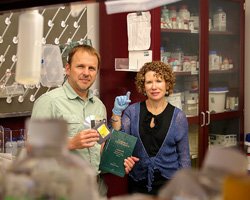Experiments at CERN’s Large Hadron Collider generate 15 million gigabytes of data per year. That is a lot of digital data to inscribe on hard drives or beam up to the «cloud.»

Sandia National Laboratories bioengineers Marlene and George Bachand show off their new method for encrypting and storing information in DNA. Digital data storage degrades and can become obsolete and old-school books and paper require lots of space. (Photo by Lonnie Anderson) Click on the thumbnail for a high-resolution image.
Tape- and
«Historically, the national laboratories and the U.S. government have a lot of highly secure information that they need to store
Bachand was inspired by the recording of all of Shakespeare’s sonnets into 2.5 million base pairs of DNA — about half the genome of the tiny E. coli bacterium. Using this method, the group at the European Bioinformatics Institute could theoretically store 2.2 petabytes of information — 200 times the printed material in the Library of Congress — in one gram of DNA.
Marlene Bachand, a biological engineer at Sandia and George Bachand’s spouse, added, «We are taking advantage of a biological component, DNA, and using its unique ability to encode huge amounts of data in an extremely small volume to develop DNA constructs that can be used to transmit and store vast amounts of encrypted data for security purposes.»
The Bachands’ project, funded by Sandia’s Laboratory Directed Research & Development program, has successfully moved from the drawing board to letterhead. Using a practically unbreakable encryption key, the team has encoded an abridged version of a historical letter written by President Harry Truman into DNA. They then made the DNA, spotted it onto Sandia letterhead and mailed it — along with a conventional letter — around the country. After the letter’s
Encrypting text into DNA and producing the message
To achieve this
DNA is made up of four different bases, commonly referred to by their one letter abbreviations: A, C, G and T. Using a
For example, spaces make up on average 15 to 20 percent of the characters in a text document, an encryption key could specify that TAG, TAA and TGA each code for «space» while GAA and CTC could code for «E." This would reduce the amount of repetition — technically challenging for making and reading DNA — and make
The team’s first test was to encode a
«Our initial approach was very expensive, very time consuming and didn’t work," said George Bachand. However, «there’s a new technology that’s come out and made the ability to take synthetic DNA, what are called gene blocks, and stitch them together into these artificial chromosomes. These changes have just happened within the last few years, which has made it pretty extraordinary. Now it is possible to readily make these gene blocks right on the bench top and it can be done in large,

The Bachands’ method of encrypting a message into DNA. Using a computer algorithm they can encrypt a message into a sequence of DNA. Then they chemically synthesize the DNA. The DNA can be read by DNA sequencing, and then translated and decoded using the same computer algorithm. (Image courtesy Sandia National Laboratories)
Identifying potential national security applications
Since successfully encoding, making, reading and decoding the
«We have achieved the
Two possible applications the team has identified are storing historical classified documents and barcoding/watermarking electromechanical components, such as computer chips made in the Microsystems and Engineering Sciences Applications complex, Sandia’s Department of
George Bachand imagines encoding each component’s history — when it was manufactured, the lot number, starting material, even the results of reliability tests — into DNA and spotting it onto the actual chip. Instead of having to find the serial number and look up that metadata in a digital or
To test the feasibility, Marlene Bachand spotted lab equipment with a test message, and was able recover and decode the message, even after months of daily use and routine cleaning. DNA spotted onto electronic components and stored in cool, dark environments could be recoverable for hundreds of years.
Another, more straightforward application for the Bachands’ DNA storage method would be for historical or rarely accessed classified documents. DNA requires much less maintenance than disk- or
«I hope this project progresses and expands the biological scope and nature of projects here at Sandia. I believe the field of biomimicry has no boundaries. Given all of the issues with broken encryption and data breaches, this technology could potentially provide a path to address these timely and
Source: https://share.sandia.gov/news/resources/news_releases/dna_storage/#.V4TYJ0a0O3Q


